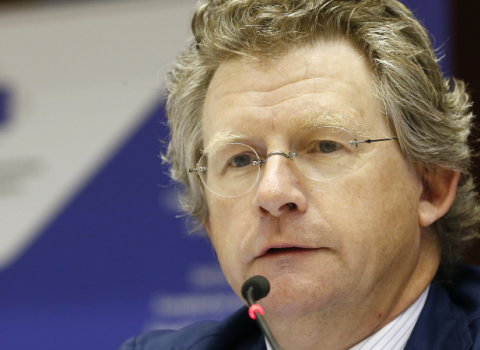
It is unlikely that David Bäckström was thinking about social networking when he started Telemedicine Clinic along with his partner, Henrik Agrell. After all, when he created the business, in Barcelona in April 2002, the term wasn’t seen as a way to raise money for new internet ventures. In effect though, with a growing global team of consultants, the company is a focused social network that offers long-distance medical diagnostic services to health services throughout Europe. Indeed, says Bäckström, “We have created a community of radiologists.”
Bäckström, a Swede, with degrees in Business Administration and Economics from The School of Business and Economics, University of Umeå, went to Barcelona in 2000 to open a branch of his second start-up, a Web site for consumers seeking the best deals from providers of telephone services, electricity and other utilities. After selling off the business, Bäckström was keen to find something that would let him stay in the city. He revisited an idea that he had first investigated a few years earlier, telemedicine.
One of those “next big ideas” that had been threatening to happen for 20 years or so, telemedicine hadn’t taken off. But the development of “Broadband Europe” and the growing use of digital imaging in medicine, meant that the technology was finally capable of sending medical images from country to country.
Bäckström also knew that back home in Sweden, and in other parts of Europe, radiologists and pathologists are in short supply. In the UK, for example, “waiting for the X rays” is a constant refrain in the country’s hospitals. Bäckström saw this as an opportunity to offer services in teleradiology, remote analysis of images from medical radiology.
The technology of modern imaging machines – X-ray and magnetic resonance imaging (MRI) – is such that, contrary to the impression given in TV series, diagnosis is not down to a medic holding an X-ray up to a light box. Today’s diagnostic imaging gathers data digitally and uses computers to create pictures on a screen.
Medicine goes digital
It was, says Bäckström, this “digitising of medicine” and reliable broadband communications, that made the time right for Telemedicine Clinic (TMC). The person scrutinising that screen can be hundreds, or even thousands, of miles away. For example, the company recently set up a diagnostic centre in Sydney, Australia. In this way, it can offer a 24-hour service that does not rely on tired medics working in the middle of the night.
The company, which likes to call itself Europe’s first virtual hospital, has customers in hospitals around the continent. They take diagnostic images of patients, mostly MRI scans, at the moment, and send these to Barcelona. There a team of experts analyses and interprets the images and returns the diagnosis to the patient’s hospital.
Why Barcelona? Apart from Bäckström’s enthusiasm for the city, one that other medics share, making it easy to attract doctors from elsewhere in Europe, costs are lower in Spain than in northern Europe. The fiscal system is also more favourable, with great tax breaks for foreigners moving into the region. The company operates from the 21st floor of a high-rise building that overlooks the Mediterranean and is next door to the Biomedical Research Centre and Hospital del Mar, one of Barcelona’s many teaching hospitals.
About half of the company’s team of some 75 diagnostic medics work out of Barcelona. TMC’s doctors are also in Sweden, Denmark, Finland, Hungary, Germany and the UK. All of the radiologists working for the company are insured and registered in the countries they read cases from.
Catalan investment
The location in Barcelona also helped in the finance front. An initial investment of €300,000 got the ball rolling. In February 2004, Invernova, a VC fund backed by the Catalan government, the Catalan Finance Institute and the Centre for Innovation and Business Development, invested a further €2 million. This VC cash gave the company the credibility it needed to offer public services.
In September 2005, Molins Capital Inversión, the first VC fund of Active Capital Partners, acquired 16 per cent of TMC. This gave the business the cash it needed to develop its services and to move into new regions. Then in September 2007 the company raised a further €7 million in a round led by Kennet Partners.
TMC makes it possible for smaller local hospitals to provide the same sort of expert diagnosis that is taken for granted in larger specialist medical centres.
The company reckons to take 36 hours to do what can take three weeks in hospitals. With customers in Sweden, Norway and the UK, TMC uses a secure communications network that connects to, for example, 95 per cent of the hospitals in Sweden through Sjunet, the country’s healthcare network.
Thanks to Sjunet, the Sollefteå Hospital, in a remote part of northern Sweden, has farmed out some non-emergency examinations to TC, reducing the need for an extra radiologist. This remote diagnosis halved the waiting time for non-emergency MRI scans. As Bäckström sees it, patients may have to go to hospitals, but there is no reason why all of the expertise needed for treatment is there.
NHS contract
In April 2007, the UK’s National Health Service awarded TC a large contract for reporting services for positron emission tomography/computerised tomography (PET/CT) – a new radiology examination to detect cancer. Combined PET and CT images provide more complete information on the location and metabolism of a cancer. “With this contract,” says the company, “Telemedicine Clinic will be the largest PET/CT centre in Europe.”
As the medical community has become more comfortable with telediagnosis, it has moved away from outsourcing routine examinations, says Bäckström. Doctors increasingly call on CT for help with complicated cases that are beyond the expertise of a general radiologist. Add to this the medics’ growing acceptance of telecommunications – it can be quicker to sit down at a terminal than to wander along to the local radiology unit – and everything is in place for a rapid growth for the company.
CT’s turnover of examinations is increasing by about a factor of three every year. The company is on course to process 200,000 this year, and hopes to reach 500,000 next year.
Bäckström estimates that telemedicine could eventually account for 20 per cent of all diagnostic radiology. Not quite enough to match Facebook, but more than enough to create a large social network of radiologists, which is why CT sees training as yet another major outlet for its approach to radiology.





 A unique international forum for public research organisations and companies to connect their external engagement with strategic interests around their R&D system.
A unique international forum for public research organisations and companies to connect their external engagement with strategic interests around their R&D system.